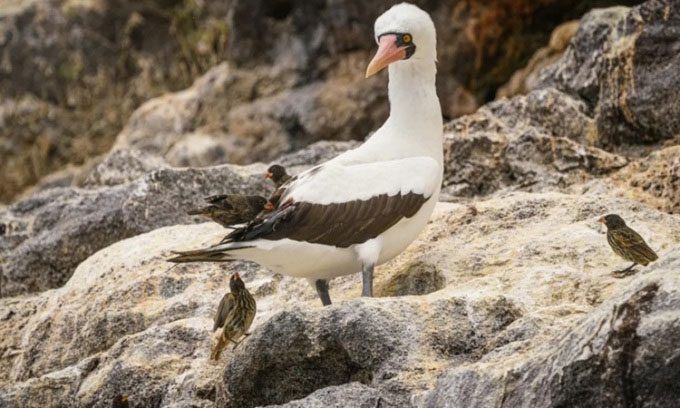The red-footed booby on Wolf Island in the Galápagos Islands is becoming a victim of vampire finches instead of predatory mammals.

A finch surrounds a booby to drink its blood. (Photo: simonjpierce)
Living on Wolf and Darwin Islands, vampire finches have adapted to scarce resources by drinking blood several times a year. The finches in the Galápagos Islands have been noted to have different beak shapes depending on their diet, which includes fruits, insects, or seeds. However, during times of water scarcity, they opt to drink the blood of boobies, according to IFL Science.
Wolf Island is extremely arid for most of the year, according to the non-profit conservation organization Galápagos Conservancy. Although the vegetation on the island produces seeds during brief rain showers, this food source does not last long for the hungry finches, forcing them to seek alternative sources of moisture and nutrients. According to a common hypothesis among researchers, they initially fed on parasites on the feathers of Nazca and red-footed boobies by pecking at their bodies. Now, the finches have taken it a step further by using their beaks to peck and drink the blood flowing from the booby’s body. When one finch inflicts a wound, other finches line up to take their turn feeding.
Although this behavior may seem gruesome, the feeding habits of the finches do not seem to bother the boobies. However, they do not stop there. Vampire finches also target booby eggs. If they cannot break the shell, they try to crack the egg by pushing it from a height. Such a significant change in diet even affects the gut microbiota of vampire finches, making them distinct from their fruit-, seed-, and insect-eating counterparts. According to a 2018 study, vampire finches (Geospiza septentrionalis) possess a unique gut microbiome due to their carnivorous-like diet.
Further research findings reveal that the microbiome of vampire finches shares many similarities with that of blood-sucking bats. This could be an example of convergent evolution, where two unrelated species evolve similar traits. Both possess high levels of Peptostreptococcaceae bacteria compared to non-blood-sucking individuals. This type of bacteria seems quite useful for processing high amounts of sodium and iron from their diet.


















































